+ Open data
Open data
- Basic information
Basic information
| Entry | Database: PDB / ID: 6zoo | ||||||||||||||||||||||||||||||
|---|---|---|---|---|---|---|---|---|---|---|---|---|---|---|---|---|---|---|---|---|---|---|---|---|---|---|---|---|---|---|---|
| Title | Photosystem I reduced Plastocyanin Complex | ||||||||||||||||||||||||||||||
 Components Components |
| ||||||||||||||||||||||||||||||
 Keywords Keywords | PHOTOSYNTHESIS / Photosystem I / membrane protein | ||||||||||||||||||||||||||||||
| Function / homology |  Function and homology information Function and homology informationresponse to low light intensity stimulus / : / plastoglobule / response to high light intensity / chloroplast thylakoid / photosynthesis, light harvesting in photosystem I / thylakoid / chloroplast thylakoid lumen / photosynthesis, light harvesting / chloroplast envelope ...response to low light intensity stimulus / : / plastoglobule / response to high light intensity / chloroplast thylakoid / photosynthesis, light harvesting in photosystem I / thylakoid / chloroplast thylakoid lumen / photosynthesis, light harvesting / chloroplast envelope / photosystem I reaction center / photosystem I / photosynthetic electron transport in photosystem I / photosystem I / photosystem II / chlorophyll binding / chloroplast thylakoid membrane / photosynthesis / response to cold / chloroplast / 4 iron, 4 sulfur cluster binding / oxidoreductase activity / electron transfer activity / copper ion binding / protein domain specific binding / mRNA binding / magnesium ion binding / metal ion binding Similarity search - Function | ||||||||||||||||||||||||||||||
| Biological species |  Pisum sativum (garden pea) Pisum sativum (garden pea) | ||||||||||||||||||||||||||||||
| Method | ELECTRON MICROSCOPY / single particle reconstruction / cryo EM / Resolution: 2.74 Å | ||||||||||||||||||||||||||||||
 Authors Authors | Nelson, N. / Caspy, I. / Shkolnisky, Y. | ||||||||||||||||||||||||||||||
| Funding support |  Israel, Israel,  Belgium, 4items Belgium, 4items
| ||||||||||||||||||||||||||||||
 Citation Citation |  Journal: Biochem J / Year: 2021 Journal: Biochem J / Year: 2021Title: Structure of plant photosystem I-plastocyanin complex reveals strong hydrophobic interactions. Authors: Ido Caspy / Mariia Fadeeva / Sebastian Kuhlgert / Anna Borovikova-Sheinker / Daniel Klaiman / Gal Masrati / Friedel Drepper / Nir Ben-Tal / Michael Hippler / Nathan Nelson /    Abstract: Photosystem I is defined as plastocyanin-ferredoxin oxidoreductase. Taking advantage of genetic engineering, kinetic analyses and cryo-EM, our data provide novel mechanistic insights into binding and ...Photosystem I is defined as plastocyanin-ferredoxin oxidoreductase. Taking advantage of genetic engineering, kinetic analyses and cryo-EM, our data provide novel mechanistic insights into binding and electron transfer between PSI and Pc. Structural data at 2.74 Å resolution reveals strong hydrophobic interactions in the plant PSI-Pc ternary complex, leading to exclusion of water molecules from PsaA-PsaB/Pc interface once the PSI-Pc complex forms. Upon oxidation of Pc, a slight tilt of bound oxidized Pc allows water molecules to accommodate the space between Pc and PSI to drive Pc dissociation. Such a scenario is consistent with the six times larger dissociation constant of oxidized as compared with reduced Pc and mechanistically explains how this molecular machine optimized electron transfer for fast turnover. | ||||||||||||||||||||||||||||||
| History |
|
- Structure visualization
Structure visualization
| Movie |
 Movie viewer Movie viewer |
|---|---|
| Structure viewer | Molecule:  Molmil Molmil Jmol/JSmol Jmol/JSmol |
- Downloads & links
Downloads & links
- Download
Download
| PDBx/mmCIF format |  6zoo.cif.gz 6zoo.cif.gz | 871.2 KB | Display |  PDBx/mmCIF format PDBx/mmCIF format |
|---|---|---|---|---|
| PDB format |  pdb6zoo.ent.gz pdb6zoo.ent.gz | 764.2 KB | Display |  PDB format PDB format |
| PDBx/mmJSON format |  6zoo.json.gz 6zoo.json.gz | Tree view |  PDBx/mmJSON format PDBx/mmJSON format | |
| Others |  Other downloads Other downloads |
-Validation report
| Summary document |  6zoo_validation.pdf.gz 6zoo_validation.pdf.gz | 14 MB | Display |  wwPDB validaton report wwPDB validaton report |
|---|---|---|---|---|
| Full document |  6zoo_full_validation.pdf.gz 6zoo_full_validation.pdf.gz | 14.7 MB | Display | |
| Data in XML |  6zoo_validation.xml.gz 6zoo_validation.xml.gz | 201.1 KB | Display | |
| Data in CIF |  6zoo_validation.cif.gz 6zoo_validation.cif.gz | 232.9 KB | Display | |
| Arichive directory |  https://data.pdbj.org/pub/pdb/validation_reports/zo/6zoo https://data.pdbj.org/pub/pdb/validation_reports/zo/6zoo ftp://data.pdbj.org/pub/pdb/validation_reports/zo/6zoo ftp://data.pdbj.org/pub/pdb/validation_reports/zo/6zoo | HTTPS FTP |
-Related structure data
| Related structure data |  11326MC M: map data used to model this data C: citing same article ( |
|---|---|
| Similar structure data |
- Links
Links
- Assembly
Assembly
| Deposited unit | 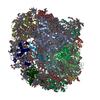
|
|---|---|
| 1 |
|
- Components
Components
-Photosystem I P700 chlorophyll a apoprotein ... , 2 types, 2 molecules AB
| #1: Protein | Mass: 82717.672 Da / Num. of mol.: 1 / Source method: isolated from a natural source / Source: (natural)  Pisum sativum (garden pea) / References: UniProt: A0A0F6NFW5, photosystem I Pisum sativum (garden pea) / References: UniProt: A0A0F6NFW5, photosystem I |
|---|---|
| #2: Protein | Mass: 82381.734 Da / Num. of mol.: 1 / Source method: isolated from a natural source / Source: (natural)  Pisum sativum (garden pea) / References: UniProt: A0A0F6NGI2, photosystem I Pisum sativum (garden pea) / References: UniProt: A0A0F6NGI2, photosystem I |
-Protein , 7 types, 7 molecules CDEGL2P
| #3: Protein | Mass: 8860.276 Da / Num. of mol.: 1 / Source method: isolated from a natural source / Source: (natural)  Pisum sativum (garden pea) / References: UniProt: P10793, photosystem I Pisum sativum (garden pea) / References: UniProt: P10793, photosystem I |
|---|---|
| #4: Protein | Mass: 16041.408 Da / Num. of mol.: 1 / Source method: isolated from a natural source / Source: (natural)  Pisum sativum (garden pea) / References: UniProt: E1C9K8 Pisum sativum (garden pea) / References: UniProt: E1C9K8 |
| #5: Protein | Mass: 7479.422 Da / Num. of mol.: 1 / Source method: isolated from a natural source / Source: (natural)  Pisum sativum (garden pea) / References: UniProt: E1C9K6 Pisum sativum (garden pea) / References: UniProt: E1C9K6 |
| #7: Protein | Mass: 10678.027 Da / Num. of mol.: 1 / Source method: isolated from a natural source / Source: (natural)  Pisum sativum (garden pea) / References: UniProt: A0A0M3KL13 Pisum sativum (garden pea) / References: UniProt: A0A0M3KL13 |
| #12: Protein | Mass: 16863.270 Da / Num. of mol.: 1 / Source method: isolated from a natural source / Source: (natural)  Pisum sativum (garden pea) Pisum sativum (garden pea) |
| #14: Protein | Mass: 22845.812 Da / Num. of mol.: 1 / Source method: isolated from a natural source / Source: (natural)  Pisum sativum (garden pea) / References: UniProt: Q41038 Pisum sativum (garden pea) / References: UniProt: Q41038 |
| #17: Protein | Mass: 10353.487 Da / Num. of mol.: 1 / Source method: isolated from a natural source / Source: (natural)  Pisum sativum (garden pea) / References: UniProt: P16002 Pisum sativum (garden pea) / References: UniProt: P16002 |
-Photosystem I reaction center subunit ... , 5 types, 5 molecules FHIJK
| #6: Protein | Mass: 17137.857 Da / Num. of mol.: 1 / Source method: isolated from a natural source / Source: (natural)  Pisum sativum (garden pea) / References: UniProt: A0A0M3KL12 Pisum sativum (garden pea) / References: UniProt: A0A0M3KL12 |
|---|---|
| #8: Protein | Mass: 10043.313 Da / Num. of mol.: 1 / Source method: isolated from a natural source / Source: (natural)  Pisum sativum (garden pea) Pisum sativum (garden pea) |
| #9: Protein/peptide | Mass: 3409.198 Da / Num. of mol.: 1 / Source method: isolated from a natural source / Source: (natural)  Pisum sativum (garden pea) / References: UniProt: P17227 Pisum sativum (garden pea) / References: UniProt: P17227 |
| #10: Protein/peptide | Mass: 4767.609 Da / Num. of mol.: 1 / Source method: isolated from a natural source / Source: (natural)  Pisum sativum (garden pea) / References: UniProt: D5MAL3 Pisum sativum (garden pea) / References: UniProt: D5MAL3 |
| #11: Protein | Mass: 8135.471 Da / Num. of mol.: 1 / Source method: isolated from a natural source / Source: (natural)  Pisum sativum (garden pea) / References: UniProt: E1C9L3 Pisum sativum (garden pea) / References: UniProt: E1C9L3 |
-Chlorophyll a-b binding protein ... , 3 types, 3 molecules 134
| #13: Protein | Mass: 21335.439 Da / Num. of mol.: 1 / Source method: isolated from a natural source / Source: (natural)  Pisum sativum (garden pea) / References: UniProt: Q01667 Pisum sativum (garden pea) / References: UniProt: Q01667 |
|---|---|
| #15: Protein | Mass: 24139.521 Da / Num. of mol.: 1 / Source method: isolated from a natural source / Source: (natural)  Pisum sativum (garden pea) / References: UniProt: Q32904 Pisum sativum (garden pea) / References: UniProt: Q32904 |
| #16: Protein | Mass: 21994.029 Da / Num. of mol.: 1 / Source method: isolated from a natural source / Source: (natural)  Pisum sativum (garden pea) / References: UniProt: Q9SQL2 Pisum sativum (garden pea) / References: UniProt: Q9SQL2 |
-Sugars , 2 types, 13 molecules 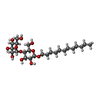


| #24: Sugar | ChemComp-LMT / #27: Sugar | ChemComp-DGD / |
|---|
-Non-polymers , 14 types, 232 molecules 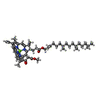

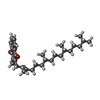





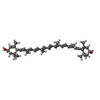
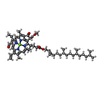
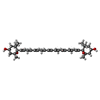
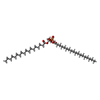
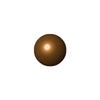














| #18: Chemical | ChemComp-CL0 / | ||||||||||||||||||||||||
|---|---|---|---|---|---|---|---|---|---|---|---|---|---|---|---|---|---|---|---|---|---|---|---|---|---|
| #19: Chemical | ChemComp-CLA / #20: Chemical | #21: Chemical | #22: Chemical | ChemComp-BCR / #23: Chemical | ChemComp-LHG / #25: Chemical | ChemComp-LMG / #26: Chemical | #28: Chemical | ChemComp-LUT / ( #29: Chemical | ChemComp-CHL / #30: Chemical | #31: Chemical | ChemComp-3PH / | #32: Chemical | ChemComp-CU / | #33: Water | ChemComp-HOH / | |
-Details
| Has ligand of interest | N |
|---|---|
| Has protein modification | Y |
-Experimental details
-Experiment
| Experiment | Method: ELECTRON MICROSCOPY |
|---|---|
| EM experiment | Aggregation state: PARTICLE / 3D reconstruction method: single particle reconstruction |
- Sample preparation
Sample preparation
| Component | Name: Photosystem I plastocyanin complex / Type: COMPLEX / Entity ID: #1, #10-#11, #13-#14, #16-#17, #2-#7, #9 / Source: NATURAL |
|---|---|
| Molecular weight | Value: 0.65 kDa/nm / Experimental value: YES |
| Source (natural) | Organism:  Pisum sativum (garden pea) Pisum sativum (garden pea) |
| Buffer solution | pH: 7 / Details: 20mM Mes-Tris, 10mM sodium ascorbate |
| Specimen | Conc.: 2.8 mg/ml / Embedding applied: NO / Shadowing applied: NO / Staining applied: NO / Vitrification applied: YES |
| Specimen support | Grid material: COPPER / Grid mesh size: 300 divisions/in. / Grid type: Quantifoil R1.2/1.3 |
| Vitrification | Cryogen name: ETHANE |
- Electron microscopy imaging
Electron microscopy imaging
| Experimental equipment |  Model: Titan Krios / Image courtesy: FEI Company |
|---|---|
| Microscopy | Model: FEI TITAN KRIOS |
| Electron gun | Electron source:  FIELD EMISSION GUN / Accelerating voltage: 300 kV / Illumination mode: FLOOD BEAM FIELD EMISSION GUN / Accelerating voltage: 300 kV / Illumination mode: FLOOD BEAM |
| Electron lens | Mode: BRIGHT FIELD / Nominal magnification: 130000 X / Nominal defocus max: 1500 nm / Nominal defocus min: 300 nm / Calibrated defocus min: 300 nm / Calibrated defocus max: 1500 nm / C2 aperture diameter: 20 µm |
| Specimen holder | Cryogen: NITROGEN |
| Image recording | Average exposure time: 2.49 sec. / Electron dose: 40.8 e/Å2 / Film or detector model: GATAN K3 (6k x 4k) / Num. of real images: 6129 |
- Processing
Processing
| Software | Name: PHENIX / Version: 1.19.2_4158: / Classification: refinement | ||||||||||||||||||||||||||||||||
|---|---|---|---|---|---|---|---|---|---|---|---|---|---|---|---|---|---|---|---|---|---|---|---|---|---|---|---|---|---|---|---|---|---|
| EM software |
| ||||||||||||||||||||||||||||||||
| CTF correction | Type: NONE | ||||||||||||||||||||||||||||||||
| Particle selection | Num. of particles selected: 359977 | ||||||||||||||||||||||||||||||||
| Symmetry | Point symmetry: C1 (asymmetric) | ||||||||||||||||||||||||||||||||
| 3D reconstruction | Resolution: 2.74 Å / Resolution method: FSC 0.143 CUT-OFF / Num. of particles: 104127 / Num. of class averages: 4 / Symmetry type: POINT | ||||||||||||||||||||||||||||||||
| Atomic model building | B value: 38.8 / Protocol: RIGID BODY FIT / Space: REAL | ||||||||||||||||||||||||||||||||
| Atomic model building | PDB-ID: 6YEZ Accession code: 6YEZ / Source name: PDB / Type: experimental model | ||||||||||||||||||||||||||||||||
| Refinement | Cross valid method: NONE Stereochemistry target values: GeoStd + Monomer Library + CDL v1.2 | ||||||||||||||||||||||||||||||||
| Displacement parameters | Biso mean: 53.84 Å2 | ||||||||||||||||||||||||||||||||
| Refine LS restraints |
|
 Movie
Movie Controller
Controller




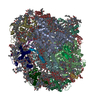
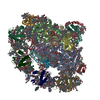

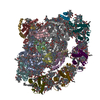

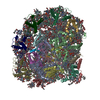
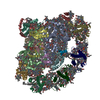
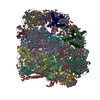


 PDBj
PDBj
























